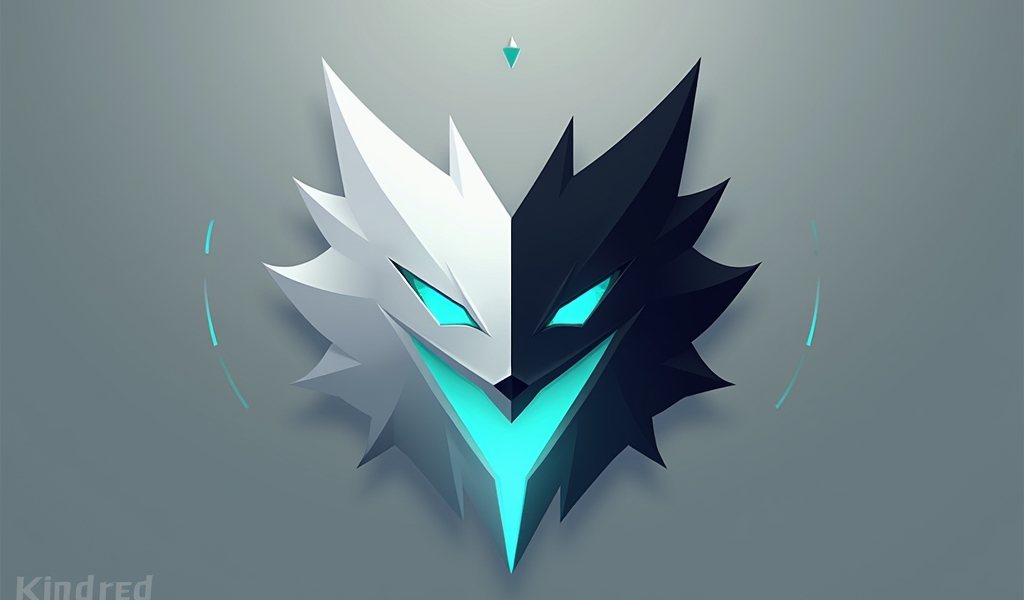Overview
How to play Kindred effectively requires mastering their unique mark collection system while balancing optimal jungle pathing, strategic ganking, and proper ultimate usage to transform from an early game ganker into a late-game hypercarry. The eternal hunters reward patient players with incredible scaling potential through permanent stat bonuses from marks, making them a versatile pick that excels at countering tanks with percent health damage while providing game-changing utility through Lamb’s Respite.
Table of Contents
Are you looking to add a unique and powerful champion to your jungle roster? Kindred might be exactly what you need. As League of Legends’ only marksman designed specifically for the jungle, this eternal hunter duo—composed of Lamb and Wolf—offers a fascinating blend of mobility, damage, and game-changing utility. What truly sets Kindred apart is their mark collection system that allows them to scale infinitely throughout the game, transforming from an early game ganker into a late-game hypercarry.
In the current meta, Kindred shines as a versatile pick that can adapt to various team compositions while maintaining consistent damage output. Their ability to counter tanks with percent health damage and save teammates with their ultimate makes them increasingly valuable as players climb the ranked ladder. Let’s dive into seven essential tips that will set you on the path to jungle mastery with this ethereal hunter.
Tip 1: Understanding Kindred’s Mark System
The heart of Kindred’s power lies in their passive, “Mark of the Kindred.” Every four marks collected provides significant stat bonuses that dramatically increase their late-game potential.
When you first pick Kindred, the game gives you a champion mark target. Choose these targets strategically—marking overextended enemies or the enemy jungler when you know their location can lead to easier kills. Avoid marking fed enemies or tanky champions that you can’t reliably take down.
For neutral monster marks, which rotate between Rift Herald, Baron, dragons, and Scuttle Crabs, timing is everything. The first mark spawns at 3:15 on a Scuttle Crab, so plan your initial clear to be near that location. After collecting four marks, keep track of respawn timers for neutral objectives to secure additional marks efficiently.
Pro tip: Each time you collect a mark, reassess the game state before selecting your next champion target. An enemy who just backed with low health might be the perfect mark when they return to lane.
Tip 2: Optimal Jungle Pathing
Your jungle path should capitalize on Kindred’s strong early dueling potential while setting you up for mark collection. A standard effective route is Red Buff → Wolves → Blue Buff → Gromp, which places you near the top or bottom river for the first Scuttle Crab mark.
Remain flexible with your pathing based on mark spawns. If your mark appears on the opposite side Scuttle, consider a vertical jungling approach by invading the enemy jungle after your initial clear to secure it.
When deciding between prioritizing marks or ganks, consider the following: if a mark is on a champion in a gankable lane, that’s your priority target. Otherwise, weigh the value of a potential kill against the permanent stats from a mark. Generally, prioritize marks in the early game to reach power spikes faster, then transition to more objective and team-focused play.

Tip 3: Gank Timing and Execution
Kindred’s ganks differ significantly from traditional junglers due to their ranged nature and mobility. Use Dance of Arrows (Q) to hop over small walls for unexpected gank angles and to quickly close distances.
When approaching a lane, save your Q until the enemy uses their escape abilities. Start with Wolf’s Frenzy (W) to create a zoning area that slows enemies who try to escape. Follow up with Mounting Dread (E) to apply a slow that makes landing your third auto attack (and the resulting execute damage) much easier.
After successful ganks, help your laner push the wave to deny enemy CS and experience, then look to secure nearby objectives like Rift Herald or dragon if your mark has spawned there. This maximizes your gank’s value beyond just the kill gold.
Tip 4: Mastering Lamb’s Respite (Ultimate)
Lamb’s Respite (R) is one of the most unique ultimates in League of Legends, creating an area where nothing can die for 4 seconds. Defensively, use it when you or a high-value teammate is about to die in a teamfight that’s otherwise winnable.
For aggressive plays, cast your ultimate when diving towers or fighting in enemy territory where you’d otherwise be at a disadvantage. The key is calculating who benefits more from the invulnerability—if you’re ahead, the enemy might benefit more than you.
Common mistakes include casting too early (before anyone is in execution range) or too late (after someone has already died). Aim to use it when health bars drop to about 15-20% for maximum value.
Position yourself at the edge of your ultimate circle so you can step out immediately when it ends, allowing you to finish low-health enemies while staying safe yourself.
Tip 5: Item Builds and Adaptations
Kindred’s core build typically revolves around attack speed and critical strike. Start with Kraken Slayer as your Mythic item for the true damage proc that synergizes perfectly with your attack speed. Follow with Phantom Dancer for movement speed and additional attack speed, then Infinity Edge to amplify your critical strike damage.
Against tanky teams, consider adding Lord Dominik’s Regards third item instead of Infinity Edge. When facing heavy burst damage, Immortal Shieldbow can replace Kraken Slayer as your Mythic choice.
Your most significant power spikes occur at 4 marks (increased attack range), Kraken Slayer completion, and 7 marks (additional attack range). Plan your objective contests and fights around these timings for maximum impact.

Tip 6: Mid to Late Game Strategy
As the game progresses, your role evolves from ganking jungler to primary damage dealer. With 7+ marks, your extended range allows you to position safely in teamfights, similar to traditional marksmen.
For objectives like dragon and Baron, arrive early to set up vision control around your mark targets. Your percent health damage makes you an excellent objective securer, especially against teams without strong smite-steal potential.
In teamfights, position behind your frontline and focus on the closest high-priority target. Unlike assassins, Kindred doesn’t need to dive the backline—your job is consistent damage output while staying alive.
When deciding between split-pushing or grouping, consider your mark count. With fewer marks, group with your team to collect champion marks. With 10+ marks, you can consider split-pushing if your team composition allows it, as you’ll be a strong 1v1 duelist.
Tip 7: Advanced Mechanics and Tricks
Master the art of wall jumps with Dance of Arrows (Q) to escape dangerous situations or create surprising engage angles. Practice in the Practice Tool to learn exactly which walls you can hop over—the thicker walls often require precise positioning.
Kiting is essential for Kindred’s survival. Practice the attack-move-click technique (A + left-click by default) to maintain distance while dealing damage, especially inside your ultimate where positioning determines who lives and who dies.
For vision control, carry a Control Ward at all times after your first back. Place these in the enemy jungle near potential mark spawns to safely track both the enemy jungler and your mark targets.
Kindred synergizes especially well with champions who can set up crowd control for your ganks, like Leona, Nautilus, or Karma’s powerful utility. Communicate with your team during champion select to create these powerful combinations.
Conclusion
Mastering Kindred requires dedication to learning their unique mark system, optimizing jungle paths that balance farming and objective control, and developing the mechanical skill to utilize their mobility in fights. The eternal hunters reward patience and practice with incredible scaling potential that few other junglers can match.
The most common challenge new Kindred players face is maintaining mark collection without dying to risky plays. Remember that your value increases over time—play for the long game rather than forcing early marks that could result in deaths.
With these seven tips as your foundation, you’re well on your way to becoming a feared Kindred player who can hunt down victories across the Rift. Much like learning how to play Kayn effectively, mastering the eternal hunters takes practice but offers tremendous rewards.
League Coach Merch is committed to helping players master champions like Kindred through in-depth guides and personalized coaching. Visit our website to explore our coaching services and exclusive League of Legends merchandise designed for dedicated players.
Frequently Asked Questions
What is the best jungle path for Kindred?
The most effective starting path for Kindred is typically Red Buff → Wolves → Blue Buff → Gromp, which positions you near a potential Scuttle Crab mark at around 3:15. However, you should always remain flexible based on where your first mark spawns and the enemy jungler’s likely pathing. If your mark appears on the opposite side Scuttle, consider adapting with an early invade after your initial clear to secure both the mark and deny the enemy jungler resources.
How do I prioritize marks versus ganks as Kindred?
When deciding between marks and ganks, follow this priority system: First, if a mark is on a champion in a gankable lane, that should be your primary target. Second, if a neutral monster mark is available and safely contestable, secure it for permanent stat bonuses. Third, look for high-percentage gank opportunities on unmarked champions. In the early game (pre-7 marks), prioritize mark collection to reach your range power spikes faster. After 7+ marks, shift more toward team objectives and fights, treating additional marks as bonuses rather than necessities.
When should I use Kindred’s ultimate effectively?
Use Lamb’s Respite in three key scenarios: defensively when you or a high-value teammate is about to die in an otherwise winnable fight; offensively when diving towers where the temporary invulnerability gives you the advantage to secure kills; and proactively in teamfights right before major burst damage is about to land. The ideal timing is when health bars drop to 15-20% – not too early (before execution range) or too late (after deaths). Position yourself at the edge of the ultimate’s radius so you can step out immediately when it ends to finish low-health enemies.
How many marks should I aim for by certain game times?
While mark collection can vary based on game circumstances, aim for these benchmarks: 4 marks by 10-12 minutes, 7 marks by 20-25 minutes, and 10+ marks in longer games (30+ minutes). The most critical thresholds are 4 marks (first range increase) and 7 marks (second range increase), which significantly improve your teamfighting capability. Don’t risk dying for marks—consistent farm and objective control are more important than forcing risky plays for marks that could set you behind.
Which champions synergize best with Kindred?
Kindred works exceptionally well with champions who provide crowd control to set up their ganks and follow-up damage. Top synergies include: laners with reliable CC like Kassadin (post-6), Lissandra, or Leona; champions with AOE ultimates that combo with Lamb’s Respite such as Karthus or Fiddlesticks; and frontliners who can protect you in teamfights like K’Sante or Maokai. Additionally, champions with global or semi-global presence like Kayle or Shen can assist you in contesting marks in the enemy jungle more safely.




